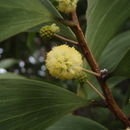Brief Summary
provided by EOL authors
Acacia koa, koa, is a large evergreen flowering tree in the Fabaceae (legume family) native to the Hawaiian Islands. Koa was prized by early Hawaiians for its exceptionally fine wood. It is the second most common tree species on the islands, and the most valuable native timber species. Its wood has a curly grain and striking coloration, and was traditionally used to build canoes, which were made of single, giant koa logs; the largest were war canoes that extended 21 m (70 ft). Koa wood was also used for surfboards, paddles, framing grasshouses, and making ukuleles. It is now used primarily for furniture, cabinet work, and face veneers. During its lifetime, A. koa undergoes a change from true leaves (consisting of compound leaves with 12 to 15 paired, bipinnate leaflets) to sickle-shaped phyllodes, leaves in which the leaflets are suppressed, and the leaf-stalks (petioles) become vertically flattened, generally oriented vertically to avoid intense sunlight. This change often occurs while plants are small, often less than 2 m (6 ft) tall. Phyllodes persist under moisture stress, transpiring about 20 percent as much as true leaves. Old trees usually bear only laurel green phyllodes, but true leaves sometimes appear on the trunk or lower branches, or after wounding. In contrast to many acacia species, A. koa is thornless. The tree may flower and fruit starting at 2 to 3 years of age. In some locations, it flowers year-round. The insect-pollinated, pale yellow flowers are arranged in axillary racemes with many hermaphroditic (bisexual) flowers. Individual flowers average 8.5 mm (0.3 in) in diameter, with one to three on a common peduncle, each with a single elongated style and an indefinite number of free stamens. The fruit is a legume or pod, slow to dehisce (split open), about 15 cm (6 in) long and 2.5 to 4 cm (1 to 1.5 in) wide. Pods contain about 12 dark brown to black seeds, which are hard and durable. Seeds may germinate after one or two years, or persist in the seed bank for 25 years or more. Koa grows best in high rainfall areas—those receiving 190 to 510 cm (75 to 200 in) annually. It is an important component of montane Hawaiian rain forests, where it grows in nearly pure stands or in mixtures with ohia (Metrosideros polymorpha), and is also associated with more than 80 species of trees, shrubs, vines, herbs, ferns, club mosses, grasses, and sedges. Koa forests provide habitat for numerous native forest birds, including three endangered species on the island of Hawaii: akiapolaau, Hemignathus munroi; akepa, Loxops coccineus; and Hawaiian creeper, Manucerthia mana. Koa forests were more extensive in the past than they are today. Land clearing, poor cutting practices, and destruction by animals, insects, and fire have all taken a toll. Koa is susceptible to numerous native insects, including the koa moth (Scotorythra paludicola), a lepidopterus defoliator that caused mortality of one third of a stand of koas on Maui in an 1841 outbreak; such severe outbreaks occur periodically. In addition, the introduced koa haole seed weevil (Araecerus levipennis) and other seed moth species may destroy 90 percent or more of any given seed crop in the pods. Koa also suffers damage and mortality from browsing by pastured or feral cattle, pigs, sheep, and goats. Craig D. Whitesell, modified by Jacqueline Courteau
- bibliographic citation
- Whitesell, C. D. Acacia koa A. Gray, Koa. In Burns, Russell M., and Barbara H. Honkala, tech. coords. 1990. Silvics of North America: Vol. 2. Hardwoods. Agriculture Handbook 654. U.S. Department of Agriculture, Forest Service, Washington, DC.
- author
- Jacqueline Courteau (Jacqueline Courteau)

